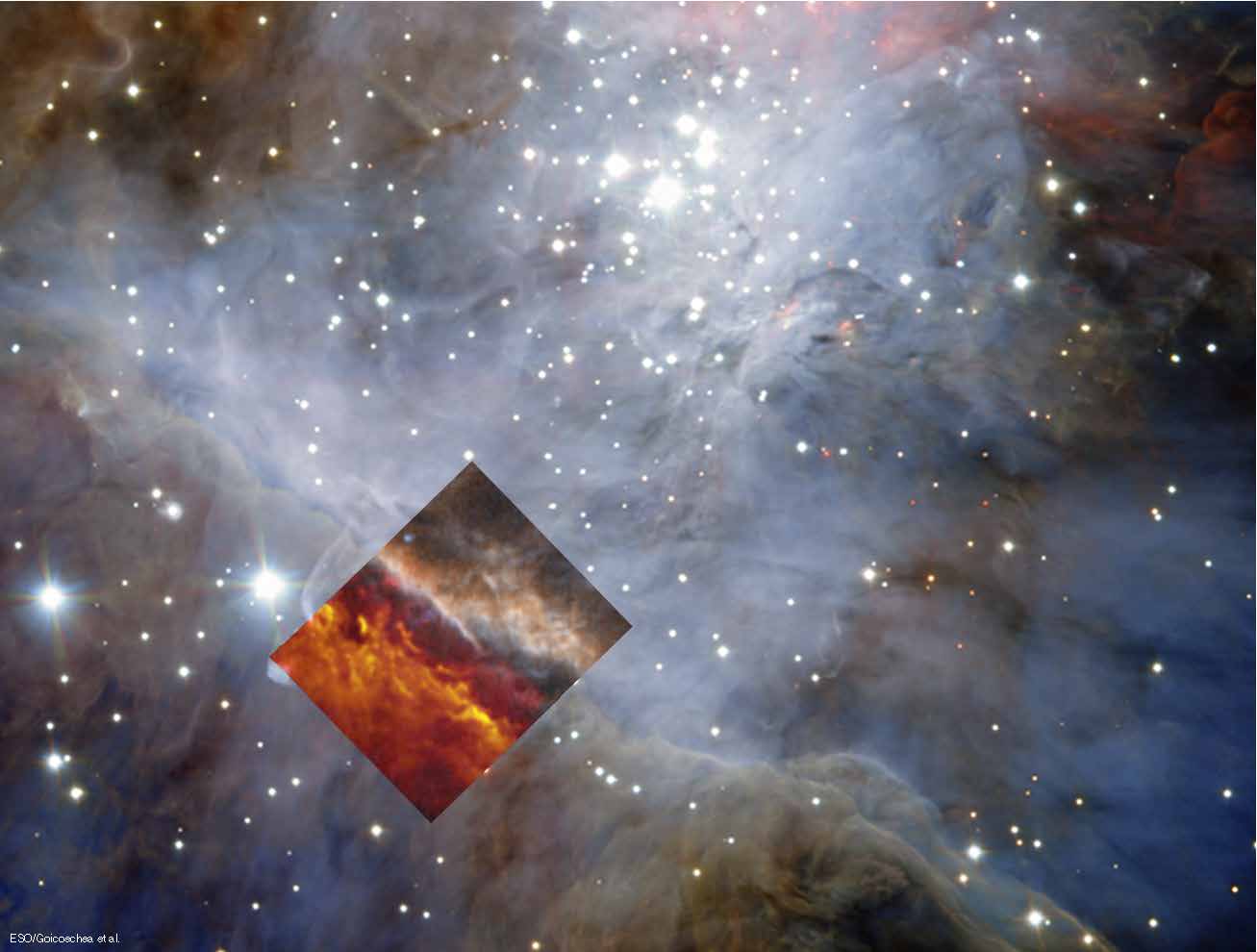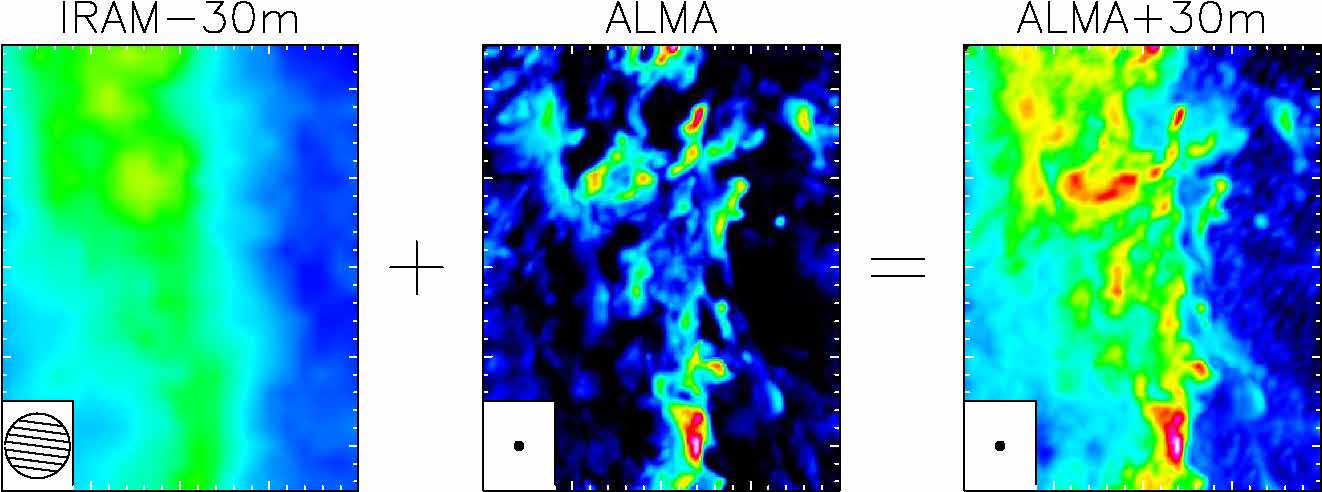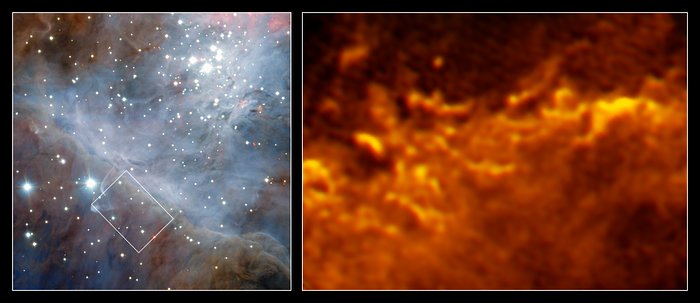News
Zooming into the skin of the Orion hunter
Combining the information from the ALMA interferometer and the IRAM 30-meter single-dish, an international team of astronomers led by Javier Goicoechea (CSIC) obtained the most detailed image of the Orion Bar, the frontier between the atomic and molecular gas in the closest massive star forming region from the solar system. This image is of considerable interest for the study of the morphology and the activity of this fascinating region of the sky.
 |
| The Big Orion nebula observed with ESO/VLT and the details of the Orion Bar are revelead by the combined ALMA+IRAM 30m image. Credits: ESO/ALMA/Goicoechea |
The Orion Nebula is at the top of the sword of the Orion constellation. This famous nebula is one of the most popular celestial attractions for amateur astronomers. The obtained colorful images reflect the intense UV illumination of the interstellar gas by a generation of young massive stars nicknamed The Trapezium. The presence of massive stars is also the reason why this region is one of the most studied by professional astronomers.
Located at 1350 light years from Earth, this is indeed the region of formation of massive stars closest to Earth. Astrophysicists thus observe this region in the prospect of revealing the secrets of formation of these monster stars that deliver about 200 000 times the solar luminosity!
Javier Goicoechea explains: "Up to now, we had an extremely static view of what happens to the molecular gas in this transition. This has changed drastically with ALMA. We obtained an image of exquisite sensitivity with a precision of 1 arcsecond, i.e., the angular size under which the solar system would be seen at the distance of Orion."
However, as any interferometer, ALMA alone would have only been sensitive to the small scale structures at the edge of the Orion Bar. This would have given a biased view of this edge. To correct for this, the team used single-dish observations obtained with the IRAM 30-meter telescope and combined both data sets to get the right answer. Jerome Pety adds: "Basically, we took a picture of the skin of the hunter constellation, while ALMA alone would have only been sensitive to the skin pores!"
 |
| The edge of the Orion molecular cloud illuminated by the Trapezium stars from the right. The first and second panels show the IRAM 30m telescope and ALMA data alone, while the third panel shows the combined final image. There are about 100 times more resolution elements in the ALMA image compared to the IRAM 30m image. In comparison, High Definition TV only multiplies by 4 the number of pixels! Credits: IRAM/ALMA/Pety |
Javier Goicoechea continues: "This combination reveals that the edge of the molecular cloud is composed of small filaments and globules more or less organized in periodic patterns at the edge of an extended molecular cloud. The explanation for such patterns is counter-intuitive. Indeed, in a static view, the intense UV radiation from the Trapezium stars should only dissociate molecules and ionize atoms. However, in a dynamic view, the UV field brings so much energy to the edge of the molecular cloud that it shocks it and compresses its outside layers to form the thin filaments and small globules."
 |
| These images show the edge of the vast molecular cloud that lies behind the Orion Nebula, 1400 light-years from Earth. The image of the left shows a wide-field view of the region, as seen with the HAWK-I instrument, installed at the Very Large Telescope. A small region is highlighted with a white rectangle, and the rightmost image shows that region in stunning fiery detail, observed with ALMA. Credits: ESO |
Jerome Pety enthousiastically finishes: "This compressed layer could help to protect the rest of the cloud from the harsh UV radiation. Behind the compression zone the cloud temperature decreases fast and the cloud becomes quiet enough to continue forming new generation of stars."
More information
Javier R. Goicoechea, Jérôme Pety, Sara Cuadrado, José Cernicharo, Edwige Chapillon, Asunción Fuente, Maryvonne Gerin, Christine Joblin, Nuria Marcelino & Paolo Pilleri. Compression and ablation of the photo-irradiated molecular cloud the Orion Bar. Nature. Doi:10.1038/nature18957
Press release in French at Observatoire de Paris "Zoomer sur la peau du chasseur de la constellation d'Orion"

